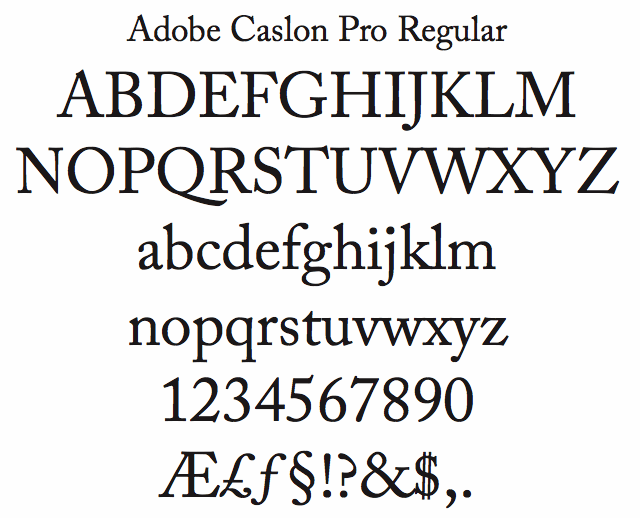TYPE DESIGN INFORMATION PAGE last updated on Thu Jan 1 10:23:10 EST 2026
FONT RECOGNITION VIA FONT MOOSE
|
|
|
|
William Caslon I was born in Worcestershire in 1692. He died in London in 1766. He was a gun smith and a typefounder. His William Caslon Foundry was established by him in 1719, and would operate in London for over 200 years. His Caslon Roman Old Face was cut between 1716 and 1728. The first fonts cut by Caslon were for Arabic (1725), Hebrew (1726) and Coptic (1731), but the designs date back to 1722. The first catalog was printed in 1734. His major influences were the Dutch designers Christoffel van Dijck and Dirck Voskens. Updike: While he modelled his letters on Dutch types, they were much better; for he introduced into his fonts a quality of interest, a variety of design, and a delicacy of modelling, which few Dutch types possessed. Dutch fonts were monotonous, but Caslon's fonts were not so. His letters when analyzed, especially in the smaller sizes, are not perfect individually; but in their mass their effect is agreeable. That is, I think, their secret: a perfection of the whole, derived from harmonious but not necessarily perfect individual letterforms. Caslon's fame stems largely from his specimen of 1734, showing types that were considered to be superior to the Dutch types that inspired them. The English reliance on Dutch types had finally come to an end. His types were just as highly regarded in America, where the Declaration of Independence was set in Caslon. His son, William Caslon II, took over the business upon his death in 1766. There are four generations of William Caslons, numbered I (1692-1766), II (1720-1778), III (1754-1833) and IV (1780-1869), who took turns running the foundry. The foundry, eventually known as H.W. Caslon&Co., passed down through various members of the family until 1937, when the rights were transferred to Stephenson Blake. Check out the free scanned version of A Specimen of Printing Types (1785, Galabin and Baker, London) by William Caslon III. A specimen of cast ornaments (1795) is by William Caslon III and Charles Whittingham (1767-1840). Recasting Caslon Old Face discusses Specimens of the original Caslon Old Face printing types, engraved in the early part of the 18th century by Caslon I (1896). A listing of some digital version/revivals of Caslon's types:
Klingspor link. FontShop link. http://www.linotype.com/348/williamcaslon.html">Linotype link. |
EXTERNAL LINKS |
| | |

file name: 3 Caslon Ancienttypes1000

file name: Caslon540 Italic

file name: Bitstream Caslon Openface 2011 10 07

file name: Bitstream Caslon540 based on A T F 1902 Poster by Bill Dawson 2015

file name: A T F Caslon Antique

file name: William Caslon Caslon

file name: William Caslon Caslon 1720 1726 Poster by Nichole Grieser 2014

file name: Caslon Poster by Euge Digon 2015

file name: Caslon Poster by Euge Digon 2015

file name: William Caslon Caslon 1725 Poster by Andrea Arques 2014

file name: William Caslon Caslon 1725 Poster by Andrea Arques 2014b

file name: William Caslon Caslon 1725 Poster by Andrea Arques 2014c

file name: William Caslon Caslon 1725 Poster by Andrea Arques 2014d

file name: William Caslon Caslon 1734 Poster by Kylee Bernard 2015

file name: William Caslon Caslon 1734 Poster by Kylee Bernard 2015b

file name: William Caslon Caslon 1734 Poster by Kylee Bernard 2015d

file name: Adobe Caslon Pro Poster by Rebecca Rapp 2017

file name: William Caslon Caslon Old Face Huge

file name: Matthew Carter Big Caslon 1994

file name: Matthew Carter Big Caslon Medium 1994

file name: Linotype Caslon3 based on A T F Caslon3 1905

file name: Linotype Caslon3 based on A T F Caslon540 1902

file name: Adobe Caslon Pro Poster by Abilash Lobo

file name: Adobe Caslon Pro Poster by Farhan Haniff 2015

file name: Adobe Caslon Pro Poster by Abilash Lobo

file name: Adobe Caslon Pro
file name: Adobe Caslon a

file name: Adobe Caslon Pro Italic

file name: Adobe Caslon Pro Ornaments

file name: William Caslon Portrait

file name: William Caslon I Portrait
| | |
|
Luc Devroye ⦿ School of Computer Science ⦿ McGill University Montreal, Canada H3A 2K6 ⦿ lucdevroye@gmail.com ⦿ https://luc.devroye.org ⦿ https://luc.devroye.org/fonts.html |


